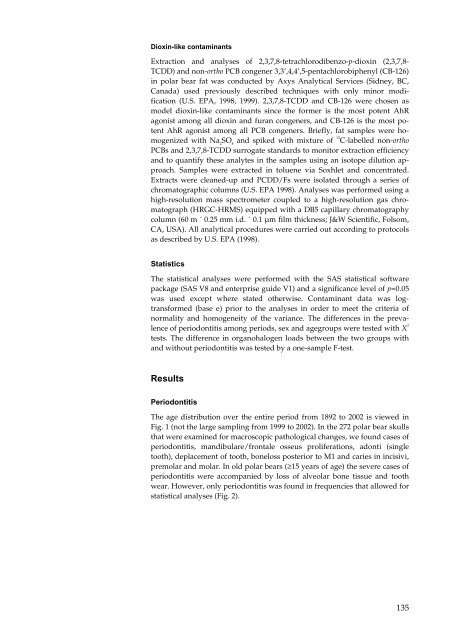Organohalogen concentrations and a gross and histologic ...
Organohalogen concentrations and a gross and histologic ...
Organohalogen concentrations and a gross and histologic ...
Create successful ePaper yourself
Turn your PDF publications into a flip-book with our unique Google optimized e-Paper software.
Dioxin-like contaminants<br />
Extraction <strong>and</strong> analyses of 2,3,7,8-tetrachlorodibenzo-p-dioxin (2,3,7,8-<br />
TCDD) <strong>and</strong> non-ortho PCB congener 3,3’,4,4’,5-pentachlorobiphenyl (CB-126)<br />
in polar bear fat was conducted by Axys Analytical Services (Sidney, BC,<br />
Canada) used previously described techniques with only minor modification<br />
(U.S. EPA, 1998, 1999). 2,3,7,8-TCDD <strong>and</strong> CB-126 were chosen as<br />
model dioxin-like contaminants since the former is the most potent AhR<br />
agonist among all dioxin <strong>and</strong> furan congeners, <strong>and</strong> CB-126 is the most potent<br />
AhR agonist among all PCB congeners. Briefly, fat samples were homogenized<br />
with Na 2 SO 4 <strong>and</strong> spiked with mixture of 13 C-labelled non-ortho<br />
PCBs <strong>and</strong> 2,3,7,8-TCDD surrogate st<strong>and</strong>ards to monitor extraction efficiency<br />
<strong>and</strong> to quantify these analytes in the samples using an isotope dilution approach.<br />
Samples were extracted in toluene via Soxhlet <strong>and</strong> concentrated.<br />
Extracts were cleaned-up <strong>and</strong> PCDD/Fs were isolated through a series of<br />
chromatographic columns (U.S. EPA 1998). Analyses was performed using a<br />
high-resolution mass spectrometer coupled to a high-resolution gas chromatograph<br />
(HRGC-HRMS) equipped with a DB5 capillary chromatography<br />
column (60 m ´ 0.25 mm i.d. ´ 0.1 µm film thickness; J&W Scientific, Folsom,<br />
CA, USA). All analytical procedures were carried out according to protocols<br />
as described by U.S. EPA (1998).<br />
Statistics<br />
The statistical analyses were performed with the SAS statistical software<br />
package (SAS V8 <strong>and</strong> enterprise guide V1) <strong>and</strong> a significance level of p=0.05<br />
was used except where stated otherwise. Contaminant data was logtransformed<br />
(base e) prior to the analyses in order to meet the criteria of<br />
normality <strong>and</strong> homogeneity of the variance. The differences in the prevalence<br />
of periodontitis among periods, sex <strong>and</strong> agegroups were tested with X 2<br />
tests. The difference in organohalogen loads between the two groups with<br />
<strong>and</strong> without periodontitis was tested by a one-sample F-test.<br />
Results<br />
Periodontitis<br />
The age distribution over the entire period from 1892 to 2002 is viewed in<br />
Fig. 1 (not the large sampling from 1999 to 2002). In the 272 polar bear skulls<br />
that were examined for macroscopic pathological changes, we found cases of<br />
periodontitis, m<strong>and</strong>ibulare/frontale osseus proliferations, adonti (single<br />
tooth), deplacement of tooth, boneloss posterior to M1 <strong>and</strong> caries in incisivi,<br />
premolar <strong>and</strong> molar. In old polar bears (≥15 years of age) the severe cases of<br />
periodontitis were accompanied by loss of alveolar bone tissue <strong>and</strong> tooth<br />
wear. However, only periodontitis was found in frequencies that allowed for<br />
statistical analyses (Fig. 2).<br />
135

















